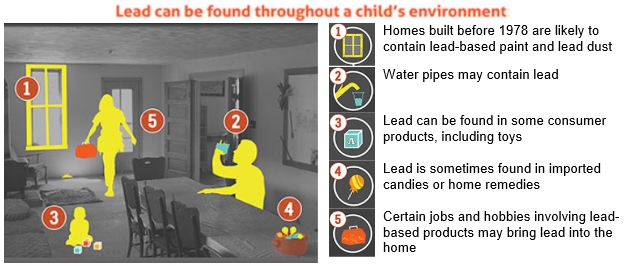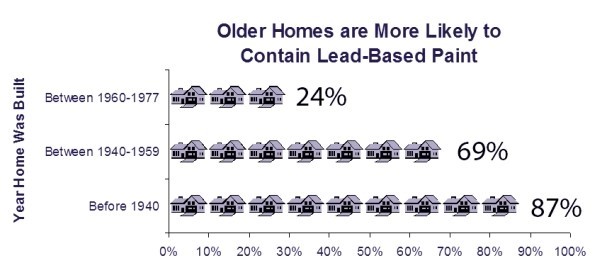Lead-based house paint, drinking water pipes, and gasoline have been banned under federal law for the past several decades. However, contamination from many preceding years of use continues to afflict cities across the United States. Washington, D.C. is no exception: it is an old city with many homes built in an era when lead-based paint and plumbing were still widely used. These sources of contamination continue to pose a threat to public health, remaining hazardous until remediated or replaced.

SOURCE: CDC NATIONAL CENTER FOR ENVIRONMENTAL HEALTH, Prevent Childhood Lead Poisoning
According to U.S. Census data, more than half of D.C. homes were built before 1950 and one third of D.C. children under the age of six live in poverty. These factors -- property age and income -- are closely correlated with likelihood of exposure to deteriorating lead-based paint and paint dust. This is because older homes are more likely to contain lead-based paint hazards, and lower income homes are less likely to have undergone the expensive and time-consuming process of lead hazard abatement.

SOURCE: ENVIRONMENTAL PROTECTION AGENCY, Protect Your Family from Exposures to Lead
Lead abatement is designed to permanently eliminate lead-based paint hazards. Following initial inspection and risk assessment designed to locate and identify all lead-based paint in a home, trained and certified professionals return and remove all identified hazards. Abatement is a meticulous, exacting, and costly process -- and the only surefire way to combat lead-based paint hazards.
Many landlords attempt to avoid the expense and hassle of proper abatement by simply covering up older layers of lead-based paint with a new, lead-free layer. However, this shortcut does nothing to eliminate the hazard: as soon as the newer layer begins to chip, the lead-based paint again becomes exposed, continuing to decay and produce toxic paint chips and dust that can be inhaled or ingested by young children.
This pattern appears to explain the recent case of a Washington, D.C. toddler whose blood lead level was elevated to a staggering 120 μg/dL -- the tragic consequence of exposure to lead-based paint in a home that had passed visual inspection by the city. At the time of inspection, the freshly painted home appeared to contain no lead-based paint, but the hazard eventually manifested itself in this devastating case of an infant now permanently disabled as a result of lead poisoning.
Long before lead-contaminated drinking water devastated the city of Flint, Michigan, residents of Washington, D.C. suffered their own public health crisis after a poorly executed adjustment in treatment protocol caused the release of lead from pipes and solder into the city's drinking water.
Lead is not normally present in drinking water, but can be released from the interior surfaces of lead service lines, pipes, and soldered joints as a result of water chemistry. Although Congress prohibited the use of lead pipes and solder in 1986, plumbing laid down before that date is likely to contain at least some lead elements.
Washington's water-lead crisis began in 2000, when the District of Columbia Water and Sewer Authority (WASA) began using chloramine as a disinfecting agent, making the water more corrosive to lead plumbing and causing water lead levels to spike. In 2001 more than half of water samples taken from District of Columbia homes exceeded the Environmental Protection Agency (EPA) action level of 15 parts per billion (ppb). In 2003, two thirds of an even larger sample set exceeded the 15 ppb action level, and over a third of homes sampled had water lead levels over 50 ppb. At that time, an estimated 23,000 D.C. households were connected to the water main by lead service lines.
Since the early 2000s, WASA has taken steps to reduce water lead levels by adding corrosion inhibitors to the treated water and by implementing a lead service line replacement program (see D.C. Code § 34-2151). However, widespread injuries to children from years of exposure to contaminated water cannot be undone.
Proximity to automotive traffic, industrial centers, and lead-painted structures can increase the lead content of urban soils relative to non-urban soils. Soil lead levels above 400 ppm are considered potentially hazardous to human health. The amount of lead in urban soils can vary from yard to yard, and even within a single yard. Residents who have not had their yard soil tested for lead should exercise care when gardening and make sure that children do not come into contact with any untested and potentially hazardous soil.
If your child has been lead-poisoned, it is critical to document their exposure through blood testing and property inspection. To speak with one of our experienced lead poisoning attorneys, please call 1-800-475-3364 or submit an email inquiry through this page.




Copyright © 2017 Levy Konigsberg LLP - Lead Poisoning Lawyers. All rights reserved.
Attorney Advertising: Prior results do not guarantee a similar future outcome.
Levy Konigsberg LLP, 800 Third Avenue, 11th Floor, New York, NY 10022.